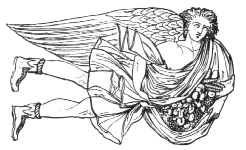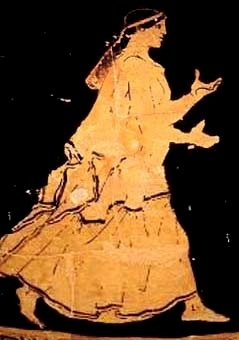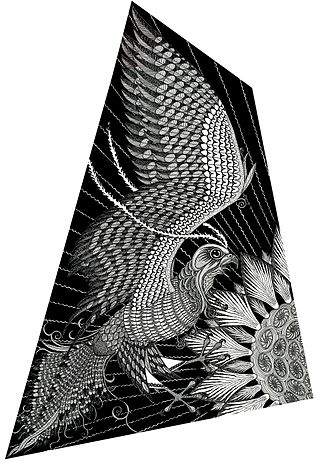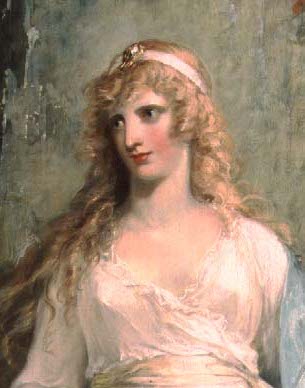Related Research Articles
Ocypete was one of the three Harpies in Greek mythology. She was also known as Ocypode or Ocythoe. The Harpies were the daughters of the sea god Thaumas and the Oceanid Electra.

In Greek mythology, Astraeus or Astraios was an astrological deity. Some also associate him with the winds, as he is the father of the four Anemoi, by his wife, Eos.

Aglaea or Aglaïa is one of the three Charites or Gratiae (Graces) in Greek mythology.

In Greek mythology, Anteros was the god of requited love and also the punisher of those who scorn love and the advances of others, or the avenger of unrequited love. He is one of the Erotes.

In Greek mythology, Psamathe is a Nereid, one of the fifty daughters of the sea god Nereus and the Oceanid Doris. By Aeacus, the king of Aegina, she is the mother of a son, Phocus. When Phocus is killed by his half-brothers Peleus and Telamon, Psamathe sends a giant wolf at Peleus' herd.
Benthesikyme or Benthesicyme in Greek mythology, according to the Bibliotheca, was a daughter of Poseidon and Amphitrite and wife of Enalos, by whom she had two daughters. She raised Eumolpus, son of Chione and Poseidon.
In Hawaiian mythology, Nu'u was a man who built an ark with which he escaped a Great Flood. He landed his vessel on top of Mauna Kea on the Big Island. Nu'u mistakenly attributed his safety to the moon, and made sacrifices to it. Kāne, the creator god, descended to earth on a rainbow and explained Nu'u's mistake. The myth has been interpreted as depicting the hazards of the Oceanian environment and local peoples' ability to withstand them. Missionaries to Hawaii in the 19th century considered him analogous to Noah of the Bible.
Stephanus or Stephan of Byzantium, was a Byzantine grammarian and the author of an important geographical dictionary entitled Ethnica (Ἐθνικά). Only meagre fragments of the dictionary survive, but the epitome is extant, compiled by one Hermolaus, not otherwise identified.

In Slavic mythology, the Raróg or Raroh is a fire demon, often depicted as a fiery falcon.

In Greek mythology, Calypso was a nymph who lived on the island of Ogygia, where, according to Homer's Odyssey, she detained Odysseus for seven years. She promised Odysseus immortality if he would stay with her, but Odysseus preferred to return home.

The Mythological Cycle is a conventional grouping within Irish mythology. It consists of tales and poems about the god-like Tuatha Dé Danann, who are based on Ireland's pagan deities, and other mythical races such as the Fomorians and Fir Bolg. It is one of the four main story 'cycles' of early Irish myth and legend, along with the Ulster Cycle, the Fianna Cycle and the Cycles of the Kings. The name "Mythological Cycle" seems to have gained currency with Arbois de Jubainville c. 1881–1883. James MacKillop says the term is now "somewhat awkward", and John T. Koch notes it is "potentially misleading, in that the narratives in question represent only a small part of extant Irish mythology". He prefers T Ó Cathasaigh's name, Cycle of the Gods. Important works in the cycle are the Lebor Gabála Érenn, the Cath Maige Tuired, the Aided Chlainne Lir and Tochmarc Étaíne.
In Japanese mythology, Ama-tsu-mika-boshi (あまつみかぼし), also called Ame-no-kagase-o (あめのかがせお), Hoshigami Kaseo, Kaseo, Amenoseo, or Ame no Murakumo no Mikoto, was originally a rebellious Shinto god, possibly malevolent, who would not submit to the will of the other Ama-tsu-kami.
The Eleionomae or Heleionomai were the naiads of the fresh-water marshes and wetlands in ancient Greek mythology.
Mene, in ancient Greek religion and Greek mythology, is an epithet of Selene, the Greek lunar goddess as a goddess presiding over the months.

The sunburst flag is an Irish flag associated with early Irish nationalism, and more recently, youth wings of Irish republican groups such as Na Fianna Éireann. The flag is first thought to have been used in 1858 by the Irish Republican Brotherhood. The sunburst flag is still used today, by both republican groups and the Irish language and Gaelic revival organization Conradh na Gaeilge.

A lacuna is a gap in a manuscript, inscription, text, painting, or musical work. A manuscript, text, or section suffering from gaps is said to be "lacunose" or "lacunulose".
Antigoneof Troy is a minor figure in Greek mythology. She is the daughter of the Trojan king Laomedon and the sister of Priam. The meaning of the name is, as in the case of the masculine equivalent Antigonus, "worthy of one's parents" or "in place of one's parents".

Wrestling Titans, also known as Fighting Giants and Giants' Gate, is a pair of outdoor sculptures leading to the first courtyard of Prague Castle, in the Czech Republic.

An Irish comic is a periodical published in Ireland that contains comic strips. Ireland's comic book market has historically been very small, and closely linked to the British market. In recent years, many comics have been released with themes drawn from Irish mythology and history. Most comics are in English, but some in the Irish language have also been produced. Authors have often portrayed Cúchulainn and the like as superheroes, and made explicit connection between them and Irish revolutionaries.